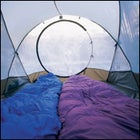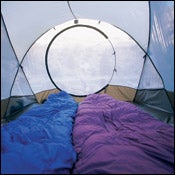Hey, Vladimir. How are things in Tokyo?

I聮m not sure I “choose” temperature ratings so much as trust what I am given by (I hope) trustworthy manufacturers, then factor in my own variables. I do like the “ten-degree rule” (meaning, if you expect to see 30 degrees F, get a bag rated to 20) due to the idea that you might be camping when you are wet, tired, calorie-drained, and not really capable of keeping up with the temperature drop. In some cases, you also can REVERSE that rule聴if you expect 30, buy a bag at 40 and use the clothes you carry to make up the difference.
Anyway聟as I infer in the paragraph above, I am assuming Fahrenheit, not Celsius, as U.S. manufacturers use that scale. If Celsius, simply take the rated temp and add or subtract five degrees Celsius, and you get to the same place.
The question of “what does a tent add?” is a difficult one. It does add something, to be sure. It keeps the wind out, captures a little bit of body heat, and so on. I have never been camping in cold weather and kept a thermometer inside the tent, then put one outside and compared the two聴but I should have by now. I聮ll estimate that if it聮s 32 degrees (0 Celsius) outside, it聮s probably at least five degrees Fahrenheit warmer inside (two or three degrees Celsius). So you can factor that in, too.
Trouble is, there are just so many variables that hard rules are, well, hard to make. Some people sleep “warm,” some do not. A good sleeping pad makes a big difference, as the ground is cold. How much you wear when turning in also makes a difference. And there is your physical condition when you go to bed. So, a little trial and error might be in order.


